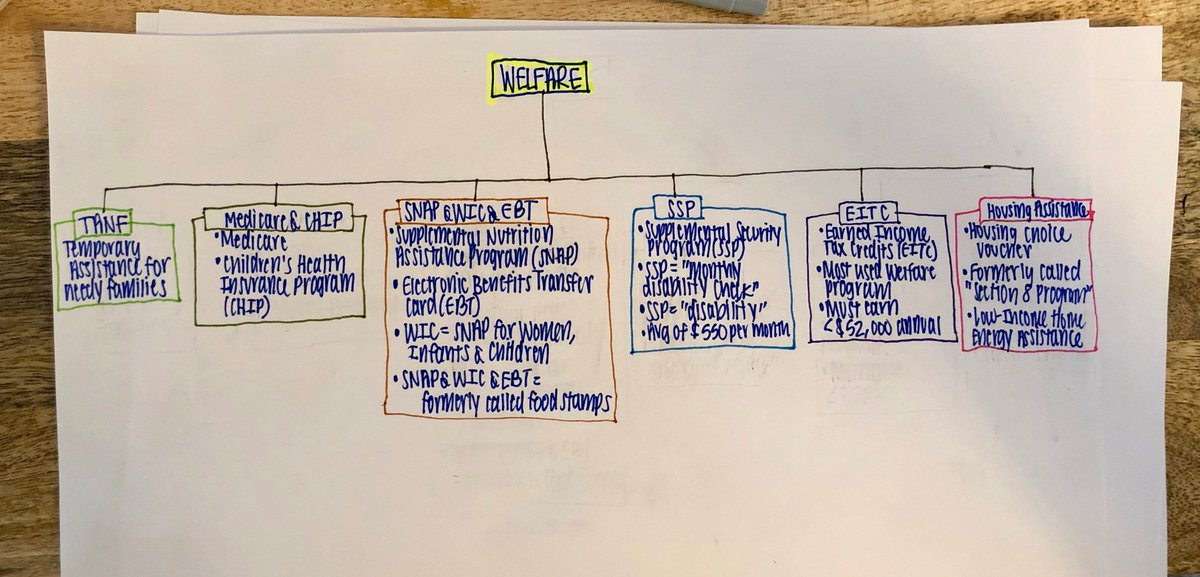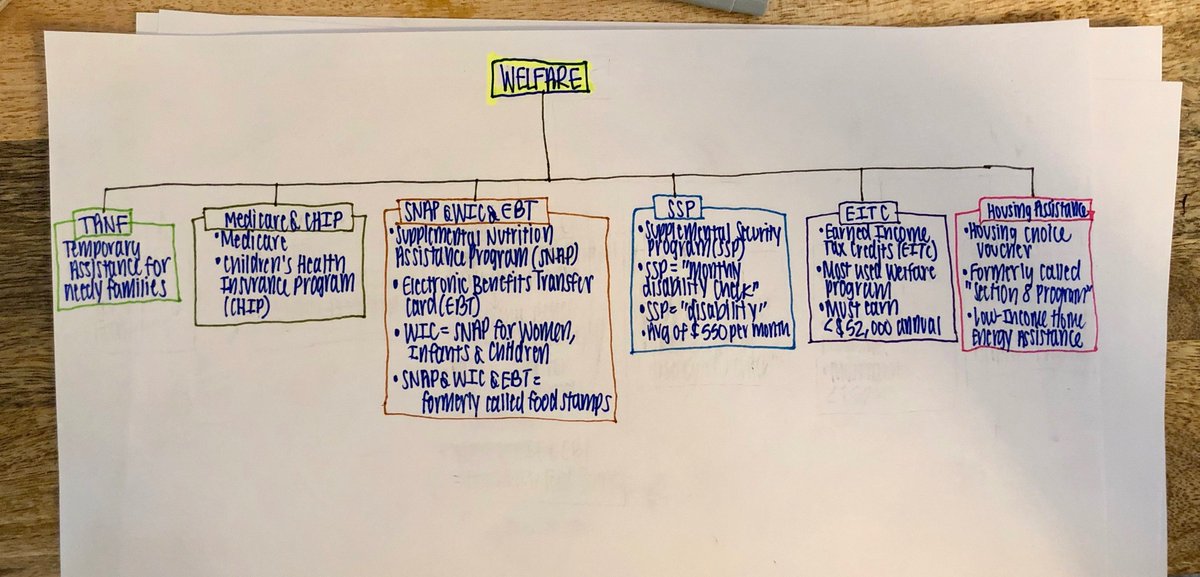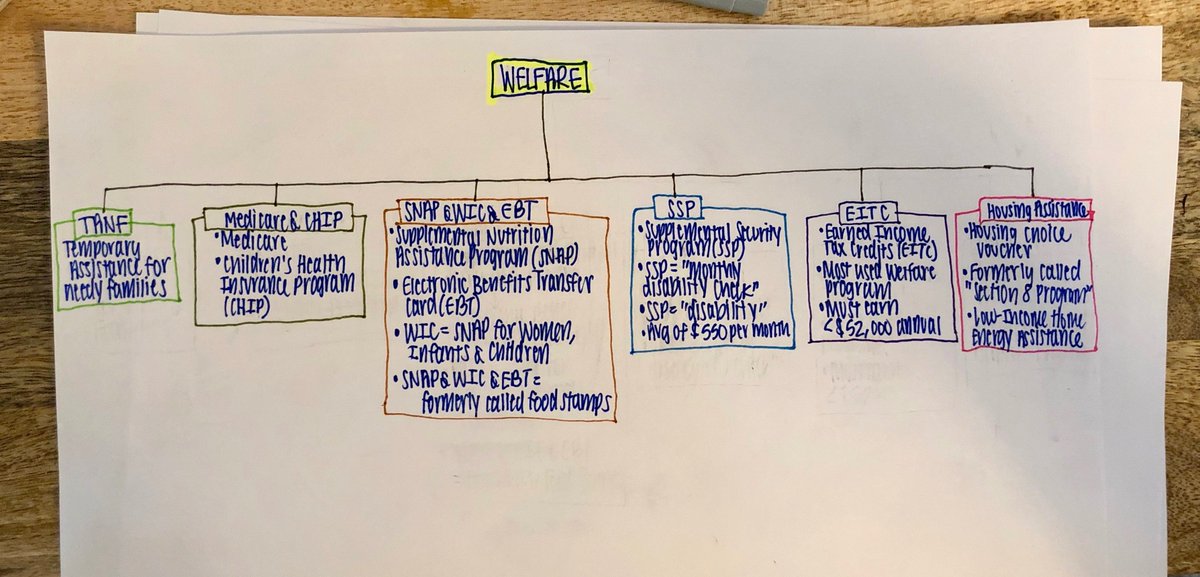Friendly reminder, 60% of med student’s parents are in the upper 10% of income earners, so most of y’all didn’t get this experiential learning like I did.
Without further ado, the thread:
/3
Without further ado, the thread:
/3
The 1st thing you need to do is actually TALK to a social worker. I mean an actual CONVERSATION about what is offered in your community. Not just ‘overheard on rounds’. SW are saviors. Please do not try to summarize info on this thread as substitute for their expertise.
/4
/4
Basics: WELFARE is an umbrella term for 6 separate programs in the U.S. Each of the ‘welfare programs’ have unique benefits and requirements that vary by state. There are a lot of acronyms. Please excuse my terrible hand-writing abilities.
/5
/5
1. Temporary Assistance for Needy Families (TANF)
2. Medicaid & Children’s Health Insurance program (CHIP)
3. Supp Nutrition Assistance Program (SNAP, formerly ‘food stamps’), SNAP for Women, Infants, and Children (WIC) and Electronic Benefits Transfer cards (EBT cards).
/6
2. Medicaid & Children’s Health Insurance program (CHIP)
3. Supp Nutrition Assistance Program (SNAP, formerly ‘food stamps’), SNAP for Women, Infants, and Children (WIC) and Electronic Benefits Transfer cards (EBT cards).
/6
4. Supplemental Security Program (i.e. ‘monthly disability’)
5. Earned Income Tax Credits (EITC)
6. Housing Assistance, including Housing Choice Voucher (formerly Section 8 Program)
/7
5. Earned Income Tax Credits (EITC)
6. Housing Assistance, including Housing Choice Voucher (formerly Section 8 Program)
/7
Briefly, I will outline each of the 6 welfare programs and at the end provide some "Pearls".
/8
/8
TANF: Temporary Assistance for Needy Families
-TANF = Stereotyped ‘welfare’ in colloquial terms
-TANF provided monthly income to approximately 1.4 million families in 2018 (on avg $450 per month)
-Each state has own requirements for TANF. LOOK UP YOUR STATE.
/9
-TANF = Stereotyped ‘welfare’ in colloquial terms
-TANF provided monthly income to approximately 1.4 million families in 2018 (on avg $450 per month)
-Each state has own requirements for TANF. LOOK UP YOUR STATE.
/9
TANF Cont& #39;d.
TANF (welfare) Does NOT keep up with inflation. Your state is behind. https://www.cbpp.org/state-temporary-assistance-for-needy-families-programs-do-not-provide-adequate-safety-net-for-poor">https://www.cbpp.org/state-tem...
/10
TANF (welfare) Does NOT keep up with inflation. Your state is behind. https://www.cbpp.org/state-temporary-assistance-for-needy-families-programs-do-not-provide-adequate-safety-net-for-poor">https://www.cbpp.org/state-tem...
/10
MEDICAID & CHIP
-Childrens’ Health Insurance Program (CHIP)
-Medicaid Covers approximately 65 million adults & 29.5 million children
-CHIP is additional benefits covering approx 6 million children for hospital care, med supplies, lab tests.
/11
-Childrens’ Health Insurance Program (CHIP)
-Medicaid Covers approximately 65 million adults & 29.5 million children
-CHIP is additional benefits covering approx 6 million children for hospital care, med supplies, lab tests.
/11
MEDICAID/CHIP Cont& #39;d
-The ACA increased Medicaid Coverage by 28%, raised income requirements, and allowed single adults to qualify.
-CHIP has been in news recently as gov always delays renewing the program … yes… they delay 30 million kids health insurance.
/12
-The ACA increased Medicaid Coverage by 28%, raised income requirements, and allowed single adults to qualify.
-CHIP has been in news recently as gov always delays renewing the program … yes… they delay 30 million kids health insurance.
/12
SNAP, WIC, EBT
-Supplemental Nutrition Assistance Program (SNAP)
-Women, Infant, & Children (WIC)
-Electronic Benefits Transfer Card (EBT card) = debit card used to buy food
-SNAP & WIC = Formerly called “food stamps”
-Covered approx 40 million people in 2018.
/13
-Supplemental Nutrition Assistance Program (SNAP)
-Women, Infant, & Children (WIC)
-Electronic Benefits Transfer Card (EBT card) = debit card used to buy food
-SNAP & WIC = Formerly called “food stamps”
-Covered approx 40 million people in 2018.
/13
SNAP, WIC, EBT cont& #39;d
-Avg person received $130 per month.
-Those w/o children must work within 3 months of benefits
-WIC provides additional vouchers & education up to age 6.
-Child Nutrition Program = Free or reduced-cost school lunches (this was stressful for me)
/14
-Avg person received $130 per month.
-Those w/o children must work within 3 months of benefits
-WIC provides additional vouchers & education up to age 6.
-Child Nutrition Program = Free or reduced-cost school lunches (this was stressful for me)
/14
SSP (Monthly disability)
-Supplemental Security Program (SSP)
-SSP = Monthly Disability check
-Provides those who qualify w/ monthly check for food, clothing, shelter.
-Qualifications: age, blind, disability
-8.2 million ppl received avg of $550 per month in 2018.
/15
-Supplemental Security Program (SSP)
-SSP = Monthly Disability check
-Provides those who qualify w/ monthly check for food, clothing, shelter.
-Qualifications: age, blind, disability
-8.2 million ppl received avg of $550 per month in 2018.
/15
Earned Income Tax Credit (EITC)
-Tax credit for families with at least 1 kid
-For family of 4 in 2018, married filing jointly, family must earn less than $52,000 per year to qualify
-EITC is the MOST used tax credit and often the invisible form of & #39;welfare& #39;
/16
-Tax credit for families with at least 1 kid
-For family of 4 in 2018, married filing jointly, family must earn less than $52,000 per year to qualify
-EITC is the MOST used tax credit and often the invisible form of & #39;welfare& #39;
/16
EITC cont& #39;d
-In 2017, over 27 million ppl received credits totaling $65 bil for avg of $2455 per tax payer
-EITC lifted approx 9.4 million people out of poverty, over half of whom were children
/17
-In 2017, over 27 million ppl received credits totaling $65 bil for avg of $2455 per tax payer
-EITC lifted approx 9.4 million people out of poverty, over half of whom were children
/17
Housing Assistance
-Provides aprox 1.2 million units of public housing.
-Housing Choice Voucher Program gives rent certificates for approved units
-Formerly “Section 8 Housing Program”
-Low-Income Energy Assistance Program provides energy assistance for utilities
/18
-Provides aprox 1.2 million units of public housing.
-Housing Choice Voucher Program gives rent certificates for approved units
-Formerly “Section 8 Housing Program”
-Low-Income Energy Assistance Program provides energy assistance for utilities
/18
Whew. That’s a lot of acronyms and info. Thx for sticking w/ me.
Here are the PEARLS that are based on my childhood experiences and interactions with patients as well as research.
/19
Here are the PEARLS that are based on my childhood experiences and interactions with patients as well as research.
/19
(1) If someone says they are on welfare, CLARIFY with patients what that means, exactly. As you just read, there are 6 different programs.
(2) States that rely most heavily on fed benefits typically vote Republican, many do not consider tax credits as welfare.
/20
(2) States that rely most heavily on fed benefits typically vote Republican, many do not consider tax credits as welfare.
/20
(3) ***The DHS found that less than 1% of undocumented immigrants are on welfare. For your undocumented patients, get them to a SW ASAP as they do NOT qualify for Federal welfare programs typically.
Though many states have programs. ***
https://www.federalregister.gov/documents/2018/10/10/2018-21106/inadmissibility-on-public-charge-grounds
/21">https://www.federalregister.gov/documents...
Though many states have programs. ***
https://www.federalregister.gov/documents/2018/10/10/2018-21106/inadmissibility-on-public-charge-grounds
/21">https://www.federalregister.gov/documents...
(4) Soc Security and Medicare are NOT welfare. They are entitlement programs based on payroll tax contributions.
(5) Invisible sources of “welfare” include jobs from federal contracts and tax credits. Visible sources (SNAP, SSP, TANF) are more stigmatized but less utilized
/22
(5) Invisible sources of “welfare” include jobs from federal contracts and tax credits. Visible sources (SNAP, SSP, TANF) are more stigmatized but less utilized
/22
(6) Welfare has ABSOLUTELY NOTHING to do with Affirmative Action or whether you qualify as a disadvantaged student on applications.
(7) On the whole, people and patients do NOT want to be on assistance programs. This was true for my family as well.
/23
(7) On the whole, people and patients do NOT want to be on assistance programs. This was true for my family as well.
/23
As soon as you start a welfare program, your life becomes scrutinized.
You get crap lunches.
Your family gets scoffed at in grocery lines for taking too long.
You overhear things like “ohh I see she can’t afford milk but can afford that toy for her kid" about our mom.
/24
You get crap lunches.
Your family gets scoffed at in grocery lines for taking too long.
You overhear things like “ohh I see she can’t afford milk but can afford that toy for her kid" about our mom.
/24
And the thing is that we do this to patients as well. We JUDGE them implicitly for being poor. As soon as we know they are on assistance we form micro-judgments about how they ‘should’ or ‘should not’ behave. How they are “non compliant despite resources.” etc.
/25
/25
The pt who makes $100K per year as an assistant professor who doesn’t have time to get to their appointments but is just “so nice” is looked at differently than my mom, who made the $15K per as single parent of 3 who has CHIP and SNAP but can’t make it to the pharmacy.
/26
/26
Whose kid do you think has a better chance at becoming a future physician? or Nurse? There is a reason why primarily affluent people attend medical school. Stigma associated with welfare programs is one of them.
/27
/27
Thanks for reading this thread. Please leave any feedback or comments below. I was hoping to start a conversation about this topic as there is little conversation about it at my school.
/28
/28
GOALSI have on my career vision board:
-Helping to create curriculum to work with SW to teach medical students about these topics.
-A mandatory rotation at shelter / street medicine in MS3 or MS4.
-Mandatory training about community resources in MS1/MS2 prior to MS3
/29
-Helping to create curriculum to work with SW to teach medical students about these topics.
-A mandatory rotation at shelter / street medicine in MS3 or MS4.
-Mandatory training about community resources in MS1/MS2 prior to MS3
/29
Please share whatever resources you know of to help educate us and whoever reads this.
Please correct any errors you see in my thread (as there are bound to be many even though I tried to reread many times).
This is a conversation.
/30 Fin
Please correct any errors you see in my thread (as there are bound to be many even though I tried to reread many times).
This is a conversation.
/30 Fin
Pearl y& #39;all already taught me:
-Term lengths are different for American Indian and Alaskan Natives.
-Please see your LOCAL SW for more details on this.
Thanks @yukonmike80 for bringing this to my attention.
-Term lengths are different for American Indian and Alaskan Natives.
-Please see your LOCAL SW for more details on this.
Thanks @yukonmike80 for bringing this to my attention.
Second Pearl that Needs Correcting (sorry y& #39;all):
See below: https://twitter.com/tdgor/status/1193635895422771200?s=20">https://twitter.com/tdgor/sta...
See below: https://twitter.com/tdgor/status/1193635895422771200?s=20">https://twitter.com/tdgor/sta...

 Read on Twitter
Read on Twitter





